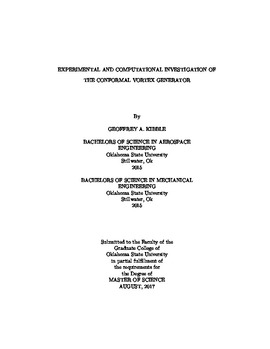| dc.contributor.advisor | Jacob, Jamey | |
| dc.contributor.author | Kibble, Geoffrey Alexander | |
| dc.date.accessioned | 2018-06-08T19:57:47Z | |
| dc.date.available | 2018-06-08T19:57:47Z | |
| dc.date.issued | 2017-08-01 | |
| dc.identifier.uri | https://hdl.handle.net/11244/300000 | |
| dc.description.abstract | Passive flow control devices, such as vortex generators or riblets, have limited applications and often provide benefits with the expense of drag or increased cost. Many flow control methods have come and gone due to the lack of practical applications. The Edge Aerodynamix Conformal Vortex Generator (CVG) is different than these previous devices because it has been shown to drastically reduce fuel consumption in transport category aircraft without noticeable adverse side effects. Therefore, this investigation of the CVG device, which will lead to future evaluation and characterization of its leveraged drag mechanism, sought to produce an appropriate scaling relationship for the CVG, reproduce experimental flight test results computationally, and study the properties of the flow at the CVG device. Experimental work was accomplished with water and wind tunnel facilities utilizing flow visualization and particle velocimetry (PIV) flow field measurements. Computational work was accomplished with STAR-CCM+ commercial CFD software and Pointwise grid software. Experimental and computational studies evaluated multiple scaling approaches and found that the CVG device is sensitive to geometrical and boundary layer properties. Computational simulation results reproduced wall shear stress patterns observed in Edge Aerodynamix flight tests. 2D flow simulations over specific airfoil sections, which correspond to Edge Aerodynamix flight test vehicles, were produced to provide flow boundary layer properties at the CVG device. The transonic shock oscillating behavior was investigated through visualization videos during fuel consumption flight tests, which suggested that the CVG device may dampen high-frequency shock oscillations; and therefore, could account for significant drag reduction. This work was limited by the lack of an adequate experimental scaling relationship and subsequent experimental results for CFD validation. However, a scaling approach was identified for future experimental testing. Additionally, the computational work was limited by the turbulence model used and the lower-order discretization schemes employed, and therefore, future work should build upon the recommendations presented. The work accomplished will lead to further scaling development and ultimately the evaluation and characterization of the CVG drag device. | |
| dc.format | application/pdf | |
| dc.language | en_US | |
| dc.rights | Copyright is held by the author who has granted the Oklahoma State University Library the non-exclusive right to share this material in its institutional repository. Contact Digital Library Services at lib-dls@okstate.edu or 405-744-9161 for the permission policy on the use, reproduction or distribution of this material. | |
| dc.title | Experimental and Computational Investigation of the Conformal Vortex Generator | |
| dc.contributor.committeeMember | Santhanakrishnan, Arvind | |
| dc.contributor.committeeMember | Elbing, Brian | |
| osu.filename | Kibble_okstate_0664M_15105.pdf | |
| osu.accesstype | Open Access | |
| dc.description.department | Mechanical & Aerospace Engineering | |
| dc.type.genre | Thesis | |
| dc.type.material | text | |
